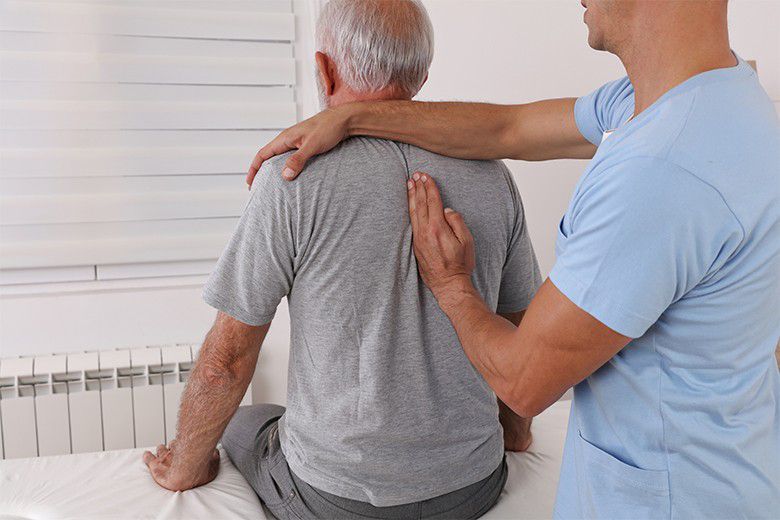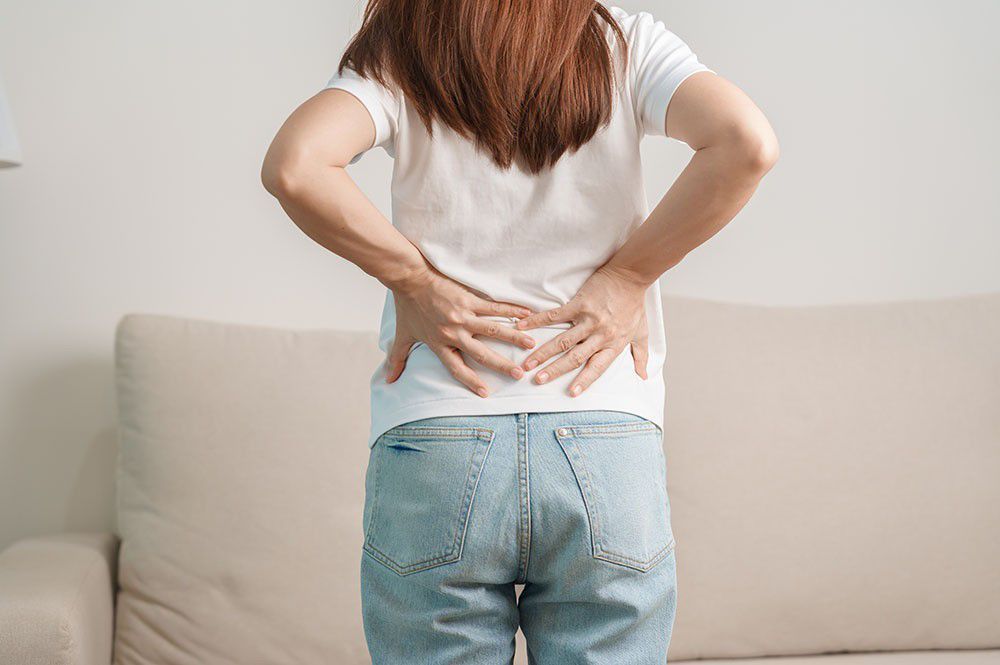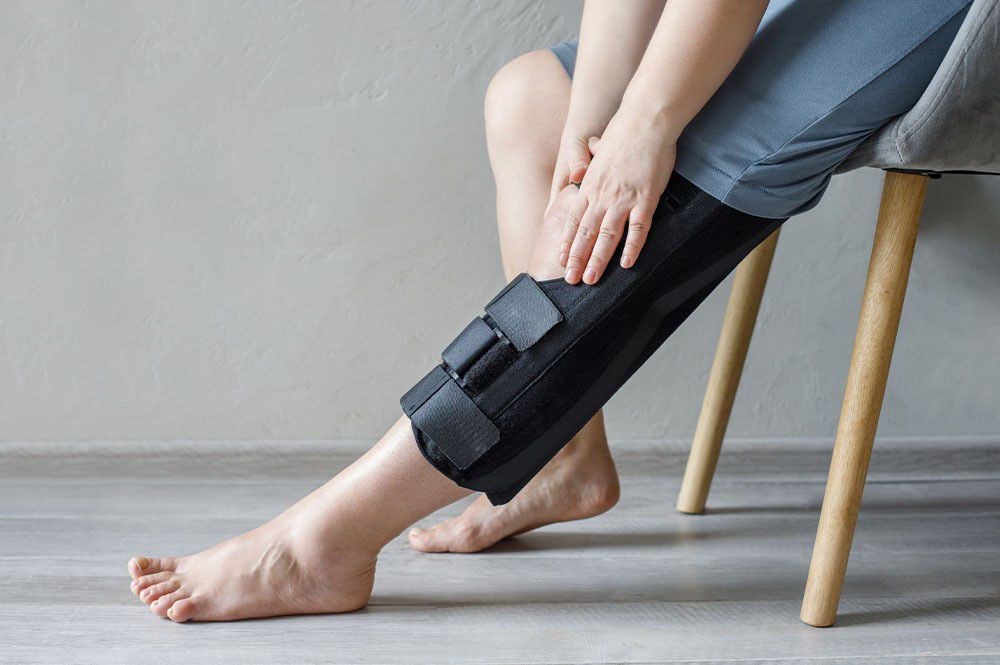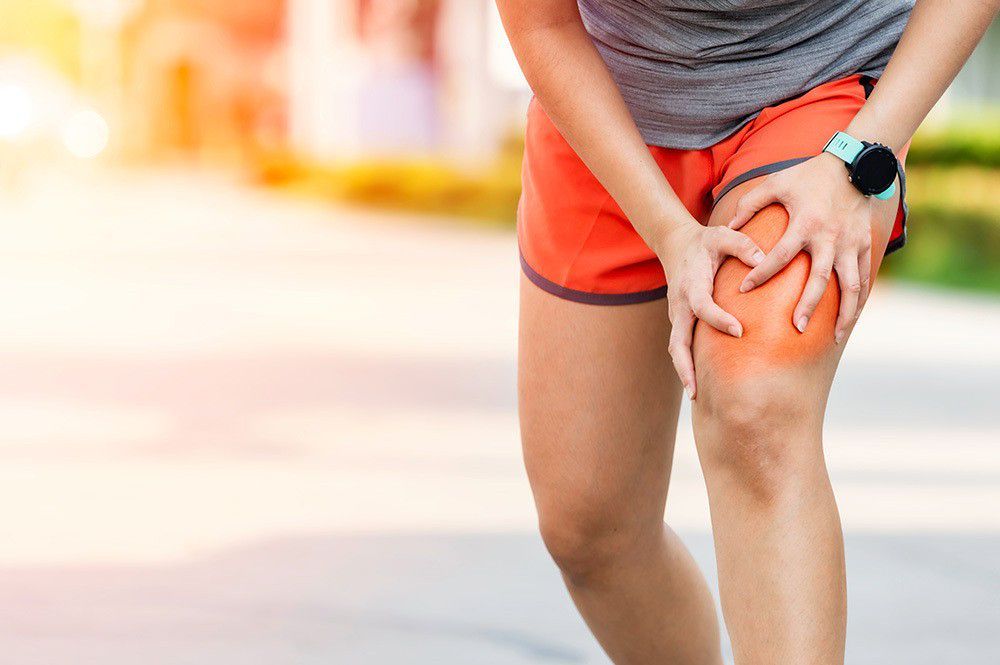Herniated lumbar disc: what to do

- 1 How to treat herniated lumbar disc?
- 2 Physiotherapy and lumbar disc hernia
- 3 Prevention
Herniated lumbar disc
Sudden stabbing pain in the back and/or legs, sometimes accompanied by tingling, numbness, or a feeling of weakness, are classic symptoms of a herniated disc.
The pain is often so intense that the sufferer usually tries not to move or moves as little as possible.
The intervertebral disc is an elastic shock absorber between the vertebral bodies, consisting of a fibrous ring and a gelatinous core (like a water cushion).
The intervertebral disc not only adapts to the body’s movements but is even dependent on it because it is only nourished with the minerals and fluid required by the forces of traction and compression.
Epidemiology and etiology of lumbar disc herniation
Men are twice as likely to suffer from herniated discs as women; the most affected are young people between 30 and 50 years of age.
In nine out of ten cases, the herniated disc is in the lumbar spine.
The cervical spine is affected less frequently, and the thoracic spine very rarely.
Sometimes those affected experience no pain and discover the herniated disc only by chance.
These are the leading causes of a herniated disc:
Repeated overloading of the fibrous ring leads to wear on the intervertebral discs.
-For example, holding certain positions for too long in an unfavorable manner.
Classic examples are long times and awkward postures while sitting at a PC or gardening in a bent posture.
-Lifting and carrying weights with an incorrect posture can also overload the fibrous ring, as the pressure on it can increase up to eight times the body weight.
-It is usually a combination of various overloads that eventually causes the fibrous ring to rupture.
If cracks develop in the fibrous ring, a so-called protrusion occurs, which is a preliminary stage of a herniated disc, in which the disc protrudes beyond the edge of the spinal column.
This is the time when physiotherapy should be sought out. With the help of targeted exercises that, among other things, stabilize the back, the tissue can be relieved from overload and sometimes moved back so that the symptoms disappear.
However, if all layers of the fibrous ring tear, the gelatinous core penetrates in the spinal cord nerve’s direction, which is called a prolapse.
At this point, the herniated disc can take two forms:
1. if the prolapse protrudes from the center towards the back, all the spinal nerves get crushed. In the lumbar spine, this can mean that you suddenly can no longer control the passage of feces or urine properly.
You may also suddenly have less or no sensation in the inner thighs and genital area. Paralysis or weakened muscles may also be the result. In this case, an operation must be performed immediately.
2. In most cases, however, the prolapse does not protrude centrally but laterally beyond the edge of the vertebra. At most, a single spinal nerve is irritated. Here, too, numbness and weakening of the muscles occur.
The patient often unconsciously assumes a relief posture to relieve the spinal nerve mechanically.
Lumbar disc hernia: how physiotherapy helps
An operation is only planned if the muscles fail, in the case of paralysis, or even if the intense pain persists for several weeks.
In eight out of ten cases, however, no surgery is necessary. With physiotherapy, symptoms can be alleviated in the long term.
In the acute phase, when the pain is fresh and very intense, the therapist and patient must find positions or techniques that relieve the pain.
Sometimes it is helpful to place a rolled-up cloth or towel under the back in the right place to ease the spine.
Gentle massages and incredibly gentle and slow active (e.g., tilting the pelvis back and forth in a lateral or sitting position) and passive (e.g., light pressure on the spine through manual therapy) movements of the back in the pain-free area have supportive effect.
They increase the affected area’s metabolism, removing inflammatory substances and providing fresh nutrients.
In the acute phase, the therapist and patient learn what to do and what not to do, and subsequently, the therapist teaches the patient the correct way to load and unload the back, as each disc problem is individual.
Full-back protection is hardly ever appropriate, but high-pressure loads on the intervertebral discs should be avoided.
Once extreme pain has been brought under control, one must analyze whether and which muscles are weak or particularly tense. If one muscle has too much tension and the other too little, this leads to a muscular imbalance.
This means the muscles cannot stabilize the back in all situations, and the individual vertebral joints can no longer function optimally.
The therapist then relaxes the muscles, uses manual therapy to make the vertebral joints flexible again, and strengthens the weakened muscles through active treatment. The patient should learn to feel when and in which parts to stiffen and/or relax.
The stabilizing muscles and the movement muscles of the trunk and abdomen must be strengthened at the right place and time to prevent relapse.
This takes into account the stresses and strains to which the patient is exposed in everyday life.
This way, potentially dangerous situations, such as lifting heavy weights, can be specifically trained for.
A herniated disc is a so-called structural injury, after which the injury heals as usual. In concrete terms, it can take up to a year before the herniated disc finally heals. However, the healing process depends on various factors and differs from person to person.
Prevention and behavioral support for herniated lumbar discs
Anyone exposed to risk factors such as sedentary or physically demanding work or is genetically predisposed should take preventive (preventative) measures to counteract the causes of herniated discs. The following applies: a strong back, strong abdominal muscles, balanced loads, and movements are the best ways to prevent a herniated disc.
Strengthening the muscles through targeted exercises, strengthening the back and abdomen, and stabilizing the spine are central to preventing, reducing, or eliminating pain.
In addition to daily mindful exercises, strengthen the back through movement sequences such as climbing stairs, running, and a generally active lifestyle. As well as relaxation and meditation also help prevent herniated discs.
With six of these behavioral tips, back problems can be prevented and alleviated at the first symptoms (e.g., disc protrusion):
1. Regular exercise: even inactive patients should seek an activity they enjoy. A regular 30-minute walk is enough to significantly improve muscle balance and prevent back problems. Even better: do sport regularly, especially back-friendly sports such as backstroke swimming, walking, cycling or cross-country skiing are suitable, or martial arts training. It is essential to find out what you like and what is good for you to continue the activity in the long term.
2. Intersperse sedentary activity: balance your daily work with constant breaks in your sitting posture. For example, walking to the photocopier or choosing specific jobs that can be done standing. Divide your work evenly between dynamic sitting, standing, and purposeful walking. Optimize your workplace as much as possible by adjusting your office chair, desk, and screen.
3. Compensate for one-sided loading and posture errors: create a balance for the back by compensating for one-sided physical and/or work activities. Yoga, postural gymnastics, swimming, water aerobics, Pilates, karate, or similar are good sports to prevent and treat back problems; choose whichever one you like best.
4. The back can be relieved regularly during the stress phase, e.g., by gently bending forward, circling the pelvis, shifting your weight, or bending your knees slightly.
5. Correct lifting and carrying: avoid carrying heavy objects over long distances without help or equipment, and ensure that your posture is gentle on your back. The targeted use of abdominal muscle activity supports the stability of the spine.
6. Avoiding stress: make sure you have good time management regarding work, family, and leisure time, devoting yourself to small moments such as sauna, meditation, music, or singing.
7. Overweight: being overweight puts a strain on your joints and spine. A healthy diet and exercise are mutually beneficial and counteract obesity. It is not about heavy dieting; it is about good eating habits. Eating regular meals, drinking enough fluids (especially water), eating plenty of fruit and vegetables, avoiding sweets, and eating slowly are the first steps toward a healthy diet.









